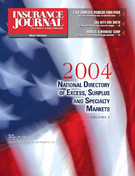A number of banks on the East Coast, and more recently in the West, have been offering insurance products through brokerage subsidiaries for several years now. Some years back, when banks started buying insurance agencies, there were some concerns about merging different corporate cultures. While there have been Dale Jansen is president and CEO of UBOC Insurance Inc., a wholly owned subsidiary of Union Bank of California, N.A., and the state’s third-largest commercial bank. Instances of disastrous acquisitions, for sure, others have delivered results beyond expectations. The key differences were in how well the post-acquisition integration was executed, how committed to the insurance business the banks were and how strongly their senior managers and boards supported the expansion.
Will we see further consolidation of the brokerage industry? I believe we will. Analyst projections indicate that economic trends will lead to further consolidation. According to research by Marsh Berry Inc., by the end of the current decade, consolidation will have transformed the U.S. insurance brokerage industry. Large national firms, with revenue ranging from $10 to $100 million, will control 66.7 percent of the market. Conversely, the number of smaller firms with revenues of $250,000 to $1 million will be greatly reduced, from 10,840 in 2000 to 4,691 by 2010.
The passage of the Gramm-Leach-Bliley Act of 1999, which broke down the barriers erected during the Great Depression between the banking and securities industries, ushered in a period of restructuring in the insurance sector. Insurance companies, pressured to increase profitability, began raising the bar for the level of premium they expected from brokerage firms in order to continue doing business with them. Increasingly, small agencies found themselves unable to invest in the future or take advantage of expansion opportunities.
Although they had opposed for years the sale of insurance by banks, some brokers started to look at the prospect of being acquired by them as critical to their survival. At the same time, banks, which were looking for strategies to increase emphasis on non-interest revenue to offset interest rate spreads, began to look at the acquisition of brokerage firms as a way to develop an annuity of fee-based income.
But while there were clear advantages for both parties to these acquisitions, such as the opportunity to cross sell products and services and the access to an expanded customer base, there were potential pitfalls as well. Not the least of which was the merging of two widely different cultures. The main concern for brokerage firms was the possible loss of independence. Agency employees also worried about change in senior management and loss of jobs. We have made three acquisitions so far and, in our case, none of these fears have materialized because we strongly believed it was best to leave the current management in place and let them continue to do what they were successful at in the first place. As it turned out, it was the best approach.
What advice would I give to brokerage firms considering selling to a bank? The key to a successful sale strategy is to find the right acquirer, one that will support the agency and maintain its autonomy. They should look for a bank whose geographical markets and sector expertise is a good match for theirs, so that the transition will be seamless for their customer base and the potential for cross selling will be optimized. A bank that is truly committed to an agency’s success will make sure that it remains competitive within the industry, both in terms of services offered and salaries and benefits paid to their employees.
What’s important is the end game: To become more competitive by offering each other’s existing and future customers an enhanced range of products and services with increased relevance to today’s economy.
Dale Jansen is president and CEO of UBOC Insurance Inc., a wholly owned subsidiary of Union Bank of California, N.A., and the state’s third-largest commerical bank.
Was this article valuable?
Here are more articles you may enjoy.


 Allstate Seeking 34% Rate Hike on California Homeowners Insurance
Allstate Seeking 34% Rate Hike on California Homeowners Insurance  Wall Street Pushes Back After Activists Escalate Protests
Wall Street Pushes Back After Activists Escalate Protests  Global Tech Outage Disrupts Industries, Highlights Online Risks
Global Tech Outage Disrupts Industries, Highlights Online Risks  Hard Market Conditions Expected to Ease in 2025 as Claims Inflation Softens: Swiss Re
Hard Market Conditions Expected to Ease in 2025 as Claims Inflation Softens: Swiss Re 


